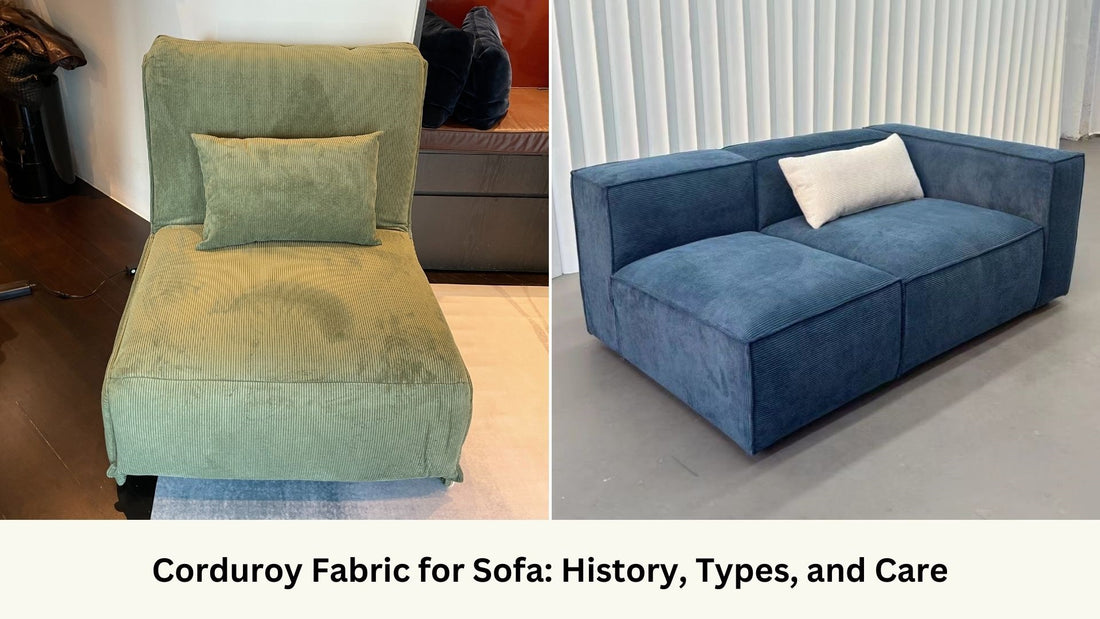
Corduroy Fabric for Sofa: History, Types, and Care
Share
Corduroy fabric is known for its distinctive ridged texture, durable weave, and vintage charm. Its unique look has stood the test of time, making a comeback in various eras of fashion and interior design. Whether you're considering corduroy for upholstery or just curious about its origins, this blog will take you through the fabric’s fascinating history, production, types, and tips for caring for it, especially if you're using it on a sofa.
The History of Corduroy Fabric
Corduroy’s roots can be traced back to ancient Egypt, where a fabric known as fustian was first woven. Fustian, a predecessor to modern corduroy, was a durable, heavy fabric with a similar pile, woven for working garments. By the 12th century, it was being produced in Europe, becoming especially popular in medieval England.
The fabric was officially named corduroy in 1774. Its name is thought to be derived from the French "corde du roi," meaning "cloth of the king," although this is debated. Regardless of its regal associations, corduroy went into widespread production in the late 18th century, largely becoming the working man’s fabric due to its durability.
In the 1970s, corduroy experienced a resurgence of popularity, becoming a symbol of countercultural fashion. The fabric achieved a cult-like status, especially in earthy tones like brown, mustard, and olive green. Since then, corduroy has remained a classic, making appearances in both fashion and interior design.
How Corduroy Fabric is Made
Corduroy’s distinctive texture is created through a multi-step process, which includes weaving, gluing, cutting, and finishing.
-
Weaving: Corduroy typically features plain weaves consisting of weft threads that alternate over and under warp threads. Once this foundational weave is created, an additional pile thread is added to form the characteristic ridges, or wales, across the fabric.
-
Gluing: To ensure the pile yarns do not pull through during the cutting process, glue is applied to the back of the woven fabric. This temporary adhesive holds the pile threads in place while the ridges are cut. Once the cutting is complete, the glue is removed in later production stages.
-
Cutting, Brushing, and Finishing: After gluing, an industrial cutter is used to sever the pile yarn. The fabric is then brushed to soften the ridges and remove excess fibers, creating a smoother finish. Finally, the fabric undergoes various finishing processes, such as dyeing, to enhance its appearance and prepare it for its final use.
Types of Corduroy Fabric Based on Wale Count
One of the defining features of corduroy is its wale count, which refers to the number of ridges or cords per inch. This count can range from very fine to wide, and it determines the overall look and feel of the fabric. Here are the most common types:
-
Pinwale Corduroy: This type has up to 21 wales per inch, giving it a fine, delicate texture. It’s often used in garments like shirts, dresses, and lightweight pants, where a softer, more flexible fabric is desired.
-
Standard Corduroy: With a wale count between 8 and 13 per inch, this is the most common type of corduroy. It strikes a balance between durability and flexibility, making it suitable for both clothing and upholstery.
-
Elephant Corduroy: Known for its wide, dramatic ridges, elephant corduroy has 1.5 to 6 wales per inch. This type is typically used for heavy-duty items like outerwear and furniture upholstery, where the bold texture can make a strong visual statement.
Corduroy Fabric for Sofas: A Perfect Match?
Corduroy is an excellent choice for a sofa, though its texture and weight make it better suited for certain types of furniture. Because the fabric isn’t particularly fluid or drapey, it works best on fitted sofas that emphasize structure and shape. The wide wale version of corduroy, such as elephant corduroy, is often favored for sofas due to its durability and bold, textured appearance. The thick ridges not only add a tactile quality but also give the sofa a cozy, vintage vibe.
Corduroy fabric also features characteristics typical of napped fabrics, which contribute to its distinctive feel and appearance. The raised fabric fibers provide a soft hand, making the surface feel plush and inviting. It can also look and feel different depending on the direction it’s touched or viewed. This effect is created by the pile fibers bending in different directions. When the fibers are pushed up, they create a slight sheen, while pushing them down results in a more matte appearance, adding a dynamic element to the fabric's look.
How to Care for a Corduroy Sofa
Corduroy’s textured surface means it can easily trap dust and debris in its ridges, making it essential to vacuum regularly. Use the brush attachment to gently clean the surface, taking care not to flatten or damage the wales.
Here are some additional care tips:
- Spot cleaning: For small spills or stains, use a damp cloth to blot the affected area. Be sure not to rub, as this could crush the pile or spread the stain.
- Avoid machine washing: While machine washing is possible, it’s not recommended for corduroy upholstery. Many corduroy fabrics are held together with glue to keep the pile intact, and machine washing could weaken this bond. Stick to professional cleaning for larger jobs or deep cleaning needs.
- Brush the fabric: After vacuuming or cleaning, use a soft-bristled brush to restore the fabric's texture. Brushing helps lift the pile and keep the wales looking crisp.
- Do not iron: Ironing can flatten the raised fibers, causing them to lose their natural sheen. This can also lead to iron stains being left on the fabric, permanently damaging its appearance.
With proper care, a corduroy sofa can last for many years, adding warmth and texture to your living space.
Published: 27th Oct 2024
